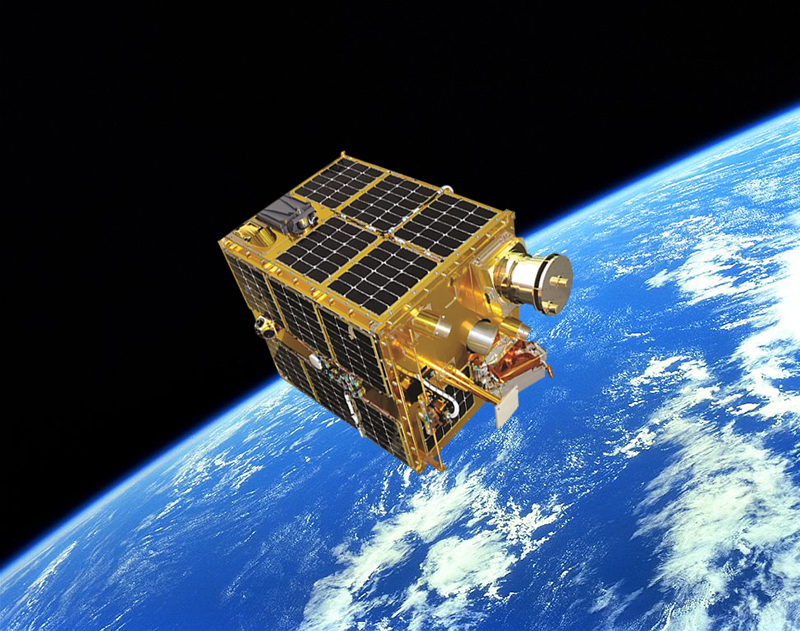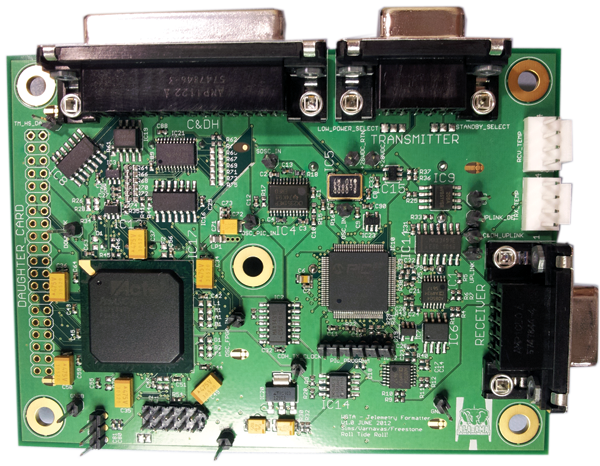
Processor Units Reduce Satellite Construction Costs
NASA Technology
In December 2008, NASA’s Marshall Space Flight Center entered into an agreement with the Department of Defense and the Van Braun Center for Space Innovation to develop the Fast Affordable Science and Technology Satellite (FASTSAT). The satellite was designed to show that within 2 years it was possible to build a small, low-cost platform, launchable on any available rocket, that could successfully carry out experiments in space and return data back to Earth.
In a market where a single satellite can cost upwards of several hundreds of millions of dollars to build, constructing one that was constrained by a $4 million budget required reconfiguring and redesigning many components. One such piece was the telemetry module—a computer processor that plays a critical role in relaying information to and from a satellite and its receiving ground station.
A telemetry module can best be described as the flight computer’s full-time interpreter. The flight computer is the satellite’s “brain” and is tasked with carrying out any and all spacecraft functions, including handling power consumption and initiating and controlling experiments. But the way it communicates both internally and externally is through transmitting raw data—an error-prone, unformatted jumble of information that would be highly burdensome for engineers to process at the receiving end on Earth.
That’s where the telemetry module comes into play: The processor encodes all outgoing raw data into a special, error-corrected protocol—transmitted through radio waves—that the ground station can use. It also works in reverse and converts the protocol sent to space back into raw data, enabling the flight computer to receive instructions in its language.
Such an important piece of equipment was mandatory for the FASTSAT, but its commercial sticker price of $1 million was cost prohibitive. Instead, NASA electrical engineers Kosta Varnavas and Herb Sims constructed their own telemetry module by using commercial, radiation-hardened parts. They also modernized the electronics system with a simpler, more durable design. Its quality construction was confirmed when the washing-machine-sized, 400-pound FASTSAT launched from Alaska in November 2010 and the telemetry unit, along with the rest of the satellite, worked seamlessly.
In fact, its performance exceeded expectations. NASA extended its original yearlong mission—to prove that such a satellite could successfully carry out the six separate experiments it was equipped with—by an additional year.
Technology Transfer
In the Fall of 2011, as the FASTSAT was approaching its first anniversary of successful operation in low-Earth orbit, former NASA mechanical engineer Bruce Weddendorf had lunch with Varnavas, his old colleague. They had worked together on a number of missions involving sounding rockets, telescopes, and balloon flights. Weddendorf was still a consultant for the Agency, but in addition to owning his own design company, he was also an entrepreneur always on the lookout for the next hot idea.
When Varnavas explained his work developing the affordable but high-quality telemetry module, it got the wheels turning in Weddendorf’s head. He recalled the rise in the use of satellite constellations, or a coordinated group of satellites that circle the Earth in low orbit. Each spacecraft monitors a section of the earth and works in tandem with other satellites to provide worldwide coverage for a variety of applications. This is in stark contrast to the larger geostationary satellites, which are positioned farther away from the Earth and, as a consequence, can provide global coverage with only two or three spacecraft.
One major advantage with using a constellation is that, if one satellite were to malfunction, the other satellites could compensate for the loss since their territories overlap. “I started thinking, this is the way the future is going,” Weddendorf says. “This telemetry unit had a lot of market potential.”
In April 2012 Weddendorf, as a result of working with Sammy Nabors from Marshall’s Technology Transfer Office, entered into an exclusive licensing agreement with NASA to sell the technology and soon after founded Hunstville, Alabama-based Orbital Telemetry Inc.
Benefits
According to Weddendorf, the rise in the use of satellite constellations poses a challenge to companies, because the cost of installing the older model telemetry units in each of what can amount to dozens of satellites quickly becomes expensive even by aerospace standards. “If you’re doing a constellation of 30 satellites in low-Earth orbit, suddenly a million dollars a telemetry module per satellite is just crazy,” Weddendorf says.
Instead, Orbital Telemetry can provide NASA-developed units at a fraction of the price. The same manufacturer who built the FASTSAT unit also produces the commercial units, and as a part of the Space Act Agreement reached with the Agency, Marshall engineers test the model afterward to make sure it meets a customer’s specifications and is reliable enough to launch into space. With his background in mechanical engineering, Weddendorf can also customize the casing. In other words, he can see the process through from beginning to end.
“All the customer has to do is hook it up to their flight computer and the radio inside their satellite, and they’re ready to launch,” he says.
Varnavas believes there’s a lot of potential in the telemetry unit, as he sees the market exploding for cheap but reliably built satellites like the FASTSAT, which concluded its operations in November 2012 after 2 successful years in orbit. “We try to keep our eyes open for any competition out there to see if there is anything comparable,” he says, “and we’re convinced that there will be a huge demand for this technology now and in the years ahead.”

Orbital Telemetry’s eponymous satellite component, which serves as a “translator” between the flight computer and the ground station, is a cost-effective alternative to traditional models.

The Fast Affordable Science and Technology Satellite (FASTSAT) was launched in 2010 to prove that a small, low-cost platform could successfully execute experiments in space. The NASAdeveloped telemetry unit used in FASTSAT saved the mission hundreds of thousands of dollars.













